Ciena’s Wayne Hickey explains the transformation of PON and fills in the blanks to help guide you to which PON is the right PON for you.
Which Passive Optical Network (PON) is the right PON for you? While APON/BPON are clearly forgotten, EPON and GPON are still being deployed, and symmetrical XGS-PON has been favored in most of the world over their asymmetrical 10G/2.5G cousin. 25GS PON’s ecosystem is developing nicely as an incremental evolution from commercial 10G technologies, 50G High Speed PON and 100G PON or CPON commercialization’s are further out. Depending on your business case and time to market, there are several PON options now and in future for consideration.
In recent blogs, we’ve talked about how XGS-PON has transformed fiber access and is rapidly becoming the technology of choice over EPON/GPON for the residential broadband market. Its 10Gb/s speeds are also enabling Small-to-Medium Business/Small-to-Medium Enterprises (SMB/SME), but it falls far short of the 10Gb/s entry level needed for larger enterprise and mobile markets. All of this will soon change as PON’s newest and rapidly growing ecosystem, 25GS-PON matures.
Today, we’ll discuss going beyond 10Gb/s speeds for larger residences, businesses, and cell sites. But before that, let’s look at the origins of PON.
PON origins
PON began in the early 1990’s as part of the Full Service Access Network (FSAN) working group. From there, the initial ITU-T standards-based Asynchronous PON (APON) was developed using Asynchronous Transfer Mode (ATM) for packet communications. APON was a more cost-effective approach than Plesiochronous Digital Hierarchy (PDH) and Synchronous Digital Hierarchy (SDH). As data speeds increased, APON was short-lived and quickly replaced with Broadband PON (BPON), which – like APON – was ATM-based as well but enabled higher speeds of 155 and 600 Mb/s (SONET-like) and other things like Ethernet access, video, etc.
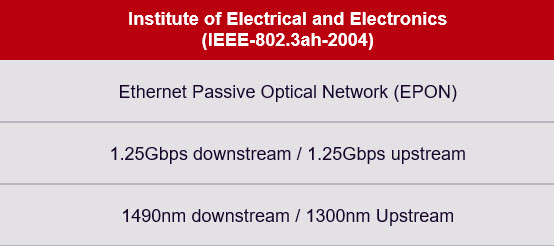
Enter Ethernet PON (EPON), which was more cost-effective using Ethernet packets versus ATM cells and had support for Internet Protocol (IP) to carry data, voice, and video. EPON can support 1.25Gb/s downstream and upstream, vastly expanding speed and services over BPON, and since it is based on Ethernet protocol, deployments are cost-effective.
EPON is defined by IEEE 802.3ah-2004, is simple to deploy but focused on data-only services. Quality of Service (QoS) for EPON is done by using Virtual Local Area Network (VLAN) tags. VLAN tagging is manually provisioned, making operations complex. EPON uses IEEE 802.ah Operations Administration and Management (OAM) along with Simple Networking Management Protocol (SMNP).
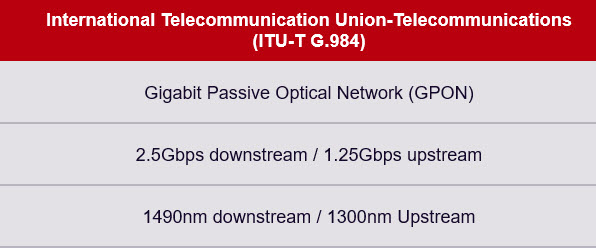
Shortly thereafter, Gigabit PON (GPON) arrived. GPON has higher bandwidth and offers multiple services when compared to EPON. Using the same protocol, various symmetrical data rates can be achieved up to 1.25Gb/s, and asymmetrically 2.5Gb/s in the downstream can also be achieved with 1.25Gb/s upstream. GPON is associated with triple-play (voice, video, and data) and has integrated QoS, making it a lower-cost option when compared to EPON. For Operations Administration and Maintenance (OAM) there are three types: OAM, Physical Layer OAM (PLOAM), and ONT Management and Control Interface (OMCI).
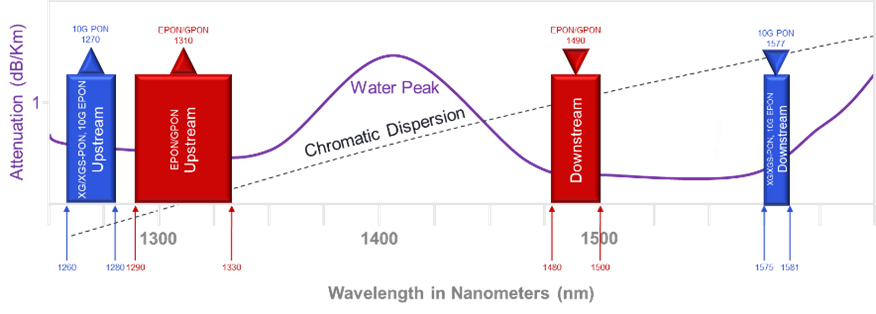
In recent years, the symmetrical XGS-PON ecosystem has fully matured, capturing a significant portion of the residential broadband market. XGS-PON has higher bandwidth and offers faster connection services compared to EPON/GPON. Various symmetrical data rates can be achieved up to 10Gb/s using the same protocol. XGS-PON shares the same functions as GPON with integrated QoS, making it lower cost. Again, for OAM there are three types: OAM, PLOAM, and OMCI.
What is PON
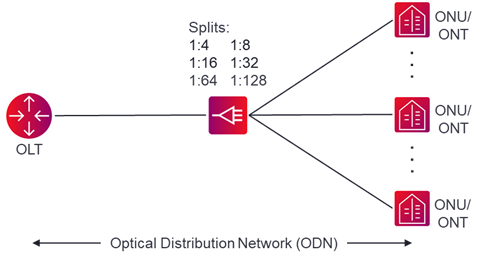
PON stands for Passive Optical Network, which uses only passive equipment in the Optical Distribution Network (ODN) between the Optical Line Terminal (OLT) and Optical Network Unit (ONU). A single OLT can serve up to 128 ONU’s. The OLT class of laser fiber type determines the reach and number of ONU’s the OLT can serve. For example, an N2 laser class can serve 64 ONU’s over 20km of single mode fiber, which is the minimum ITU-T standard requirement for all current-generation PON systems (IEEE EPON & 10G EPON require at least 32 ONUs at 20km). Reduce the distance between the OLT to the farthest ONU and more ONU’s can be added. Consequently, increasing the distance between the OLT to the farthest ONU and fewer ONU’s can be used.
ODN: Understanding fiber for PON
Whether brownfield or greenfield, fiber-optic cable is a huge component of PON’s ODN. (It is also, by far, the most expensive component, comprising as much as 90% of the cost of building a PON network). The explosive demand for higher bandwidth and faster connections makes fiber-optic cable highly desirable for the access network. But keeping within PON’s “lowest cost” mantra can be difficult depending on the business case. First, let’s consider the cost of fiber-optic transceivers for ONU/ONT and OLTs.

The single mode fiber-optic chart above shows the laser cost to manage and control both linear attenuation and fiber chromatic dispersion effects. As shown, the cost of the laser goes up when using a higher wavelength band when compared to using a lower wavelength band. The chart only considers two important linear distortions but by no means considers everything, including non-linear distortions, which can have an even greater impact on cost. Keep this in mind as PON evolves to higher speeds and other service markets; more on that later.
Given the significant expense of installing fiber cabling, a fundamental consideration for carriers is making sure that all subsequent evolutions of PON are able to utilize their existing fiber cabling without changes to the ODN itself.
ODN: ONU/ONT
PON was originally targeted as a “low-cost” point-to-point shared medium for residential broadband markets. This was enabled by using the cheapest ONU laser technology and TDM/TDMA media access control on a single fiber.
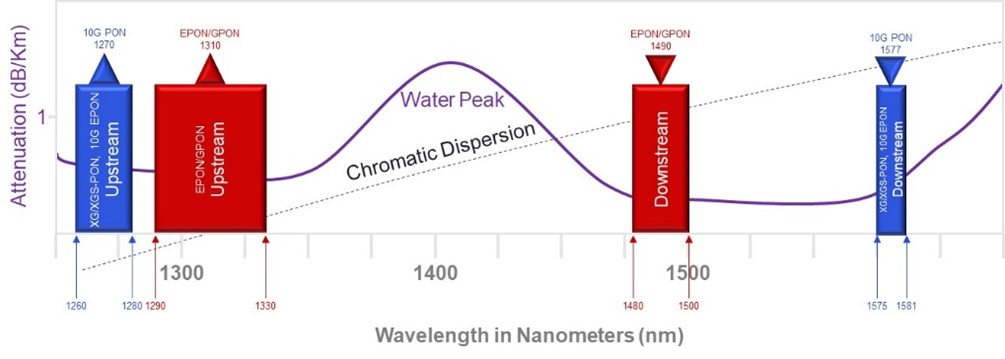
With a focus on keeping ONT/ONU equipment as low-cost as possible, EPON and GPON upstream lasers transmit between 1290nm to 1330nm, and the higher performance OLT downstream laser uses 20nm between 1480nm and 1500nm. This makes perfect sense (and dollars) for the many (i.e., 32, 64, 128 ONUs) lasers to a single OLT. The same principle is applied to 10G PON, where upstream lasers transmit between 1260 to 1280, and higher performances OLT downstream lasers transmit between 1575 and 1581.
Additionally, by using TDM/TDMA access control, the next generation of PON can simply increase the speed (i.e., 25GS-PON, etc.)
Going beyond 10G PON
EPON/GPON deployments are slowing and symmetrical 10G PON has become the new norm for residential broadband. But even with multiple Gigabit offerings, some operators are looking to provide even faster connections to the residential broadband market and most operators are looking to serve up those faster PON connections to enterprise and mobile markets. There are several options (25GS-PON, 50G HSP, and C-PON) for faster PON connections, albeit with caveats.
With 2.5 times more bandwidth, 25 Gigabit Symmetric Passive Optical Network (25GS-PON) was developed by the 25GS-PON Multi Source Agreement (MSA) group – full disclosure Ciena is a founding member. By using TDM/TDMA access control 25GS-PON can fully complement XGS-PON as an overlay, or upgrade. Again, with a focus on keeping ONT/ONU equipment as low-cost as possible, XGS-PON upstream lasers transmit at 1270/1286/1300/1310nm, and the higher performance OLT downstream laser transmits at 1342/1358nm.
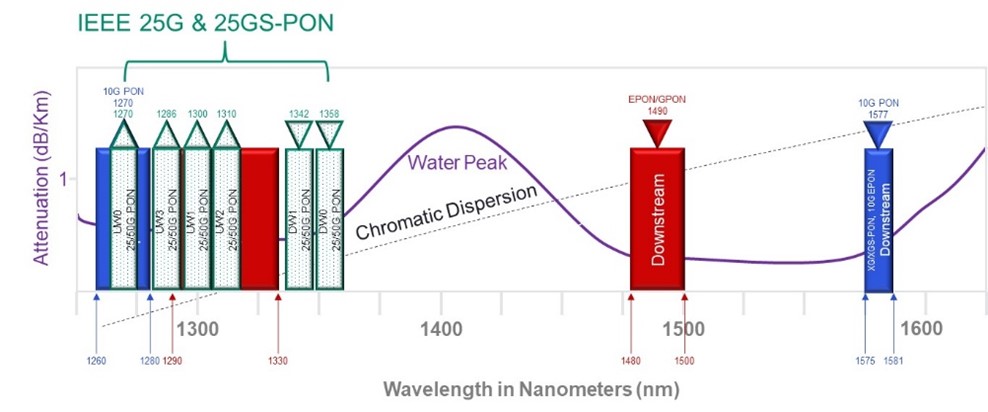
With limited deployments and a growing ecosystem, 25GS-PON is the only available technology going beyond 10G PON. However, and most important, there are millions of 25GS-PON ready ports already deployed, more on that later.
50G Higher Speed PON (HSP) proof-of-concepts (PoCs) have been shown, but it will take significant time to fulfill PON’s “lowest cost” mantra with commercial products. It is likely it will take some time for the HSP ecosystem to come of age, as maturity might not happen until later this decade.
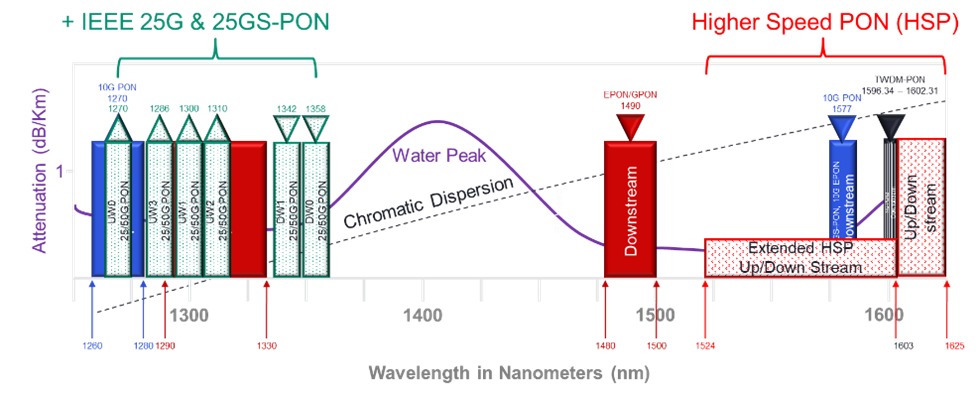
50G HSP transceiver costs will be higher to compensate for higher bandwidth and wavelengths. 50G HSP is also asymmetrical and not symmetrical. In addition, the wavelength plan is not complimentary and will require a more complex WDM system with multiple OLT channel terminations. As 50G HSP becomes commercially available, some access network operators will deploy, and others may also wait for 100G PON or CPON.
Intensity Modulation-Direct Detect (IM-DD) transceivers will likely not be used for 100G PON. In order to accommodate 100G PON on a single wavelength, the industry is looking to coherent technology. It’s no secret that coherent optical technology is used to enable farther distances than grey wavelength technology. However, 100G PON as a use case can take advantage of lower-cost designs. Cable MSO operators and service providers are reviewing this. A good question to investigate at this point is why would you deploy 50G PON today when 100G PON may be on the horizon? Deep consideration is needed before making your next PON move.
Which PON the right PON for you?
Let’s keep in mind, business, and mobile customers, really don’t care which PON they use. They want the best service at the lowest possible cost. We also know, as an operator, it is always advantageous to be the first to market with new technology. For those reasons, 25GS-PON has a great opportunity to serve the business and residential markets well before the more expensive 50G PON and 100G PON arrive.
With 25GS-PON even the existing XGS-PON OLT can be used on the same fiber. For Ciena, with 100’s of thousands of 25GS-PON ready ports, brownfield customers can simply plug in their choice of 25GS-PON or XGS-PON or both on the same router with Ciena’s Universal Aggregation Solution.
To find out today more about Universal Aggregation and ask us how Ciena helps OWN THE EDGE.






